
When you turn on an exhaust fan, it blows air from inside the house to the outdoors. That air leaving the house will be matched by an equal amount of air coming in from outside. The more airtight the house is, though, the harder it is to get that air to come in. The result is a negative pressure and maybe reduced airflow. What’s the best way to handle this situation? Do airtight houses really need makeup air?
Pressure differences
In testing for airtightness, we use a big calibrated fan called a blower door. Closing up the house and turning on the fan induces a negative pressure. The results are commonly given in terms of the amount of airflow through the fan when the pressure difference is 50 pascals (Pa). An older home might have an airflow rate of several thousand cubic feet per minute at 50 Pa (cfm50) of pressure difference. A new home might be 1500 cfm50.
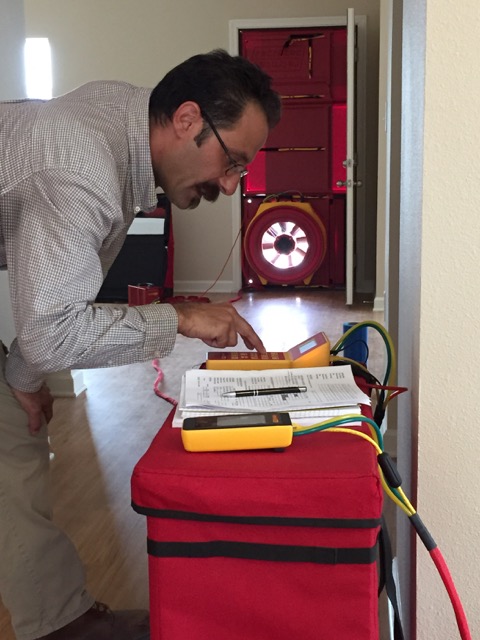
Let’s say you have a really airtight house with a blower door result of 100 cfm50. That means you get 100 cfm of airflow when the pressure difference is 50 Pa. But we can turn it around to say that an airflow rate of 100 cfm will induce a pressure difference of 50 Pa. With the house closed up, turning the range hood on low can induce that much negative pressure. Wow! That’s a big pressure difference. Is it a problem? Maybe. Maybe not.
What could happen?
Negative pressure inside the house causes it to suck air from wherever it can get it. But there are two requirements for infiltration: a pressure difference and a pathway. Air-sealing results in fewer pathways. That in turn increases the resistance to airflow when there is a pressure difference.
One thing that can happen is that your exhaust fans and clothes dryer (unless it’s a condensing or heat pump dryer) may not pull in as much air when they run. Smells and humidity may linger. Clothes may take longer to dry. Using a higher speed can help with the exhaust fans, but you may need makeup air for the dryer.
![A kitchen range hood can induce a large negative pressure in an airtight house [photo by LG, CC2.0]](https://www.energyvanguard.com/wp-content/uploads/2023/04/kitchen-range-hood-full-cropped.jpg)
(One thing you almost certainly don’t have to worry about, though, is the effect of these pressure differences on your body. When you drive to the mountains or fly in an airplane, your ears pop because of the pressure difference across your ear drum. That happens when you’ve got thousands of pascals of pressure difference. We’re talking maybe a hundred or two at most in an airtight house.)
Makeup air is difficult
We’ve done a lot of makeup air system design for our HVAC design clients, almost always for the range hood. The first thing we try to do is convince them to put in a smaller hood so they don’t need makeup air. Occasionally that actually works. When it doesn’t, we usually figure out the best way to set them up with the powered Fantech makeup air system. We’ve done a few passive makeup air systems as well.
Doing makeup air isn’t easy or cheap, though. You have to make a bunch of important decisions:
- Active or passive
- How to activate the makeup air system
- Where to put the makeup air
- Whether or not to condition the makeup air
You can spend days—or longer—investigating each one of those issues.
Food for thought
Don’t get too hung up on big pressure differences. It’s really the amount of air leakage that matters, and you get a lot more of that with low pressure differences in a leaky house. Randy Williams wrote a good article on makeup air in airtight houses for Green Building Advisor last year. In it, he quoted Gary Nelson of The Energy Conservatory:
But if the building is very tight, which it probably is because that’s why you’ve got the big pressures, and there aren’t any larger leaks, I wouldn’t be too concerned about intermittent pressures up to about 50 Pa. The reason for a 50 Pa limit is that at 50 Pa, it’s going to take about 10 pounds of force to open an exterior door and there are safety standards that limit the force to open a door to 10 pounds.
I’ve addressed only the issue of exhaust fans inducing negative pressure here. You shouldn’t have any kind of atmospheric combustion in the house other than perhaps a gas cooktop or range. Airtight houses and atmospheric combustion don’t go well together.
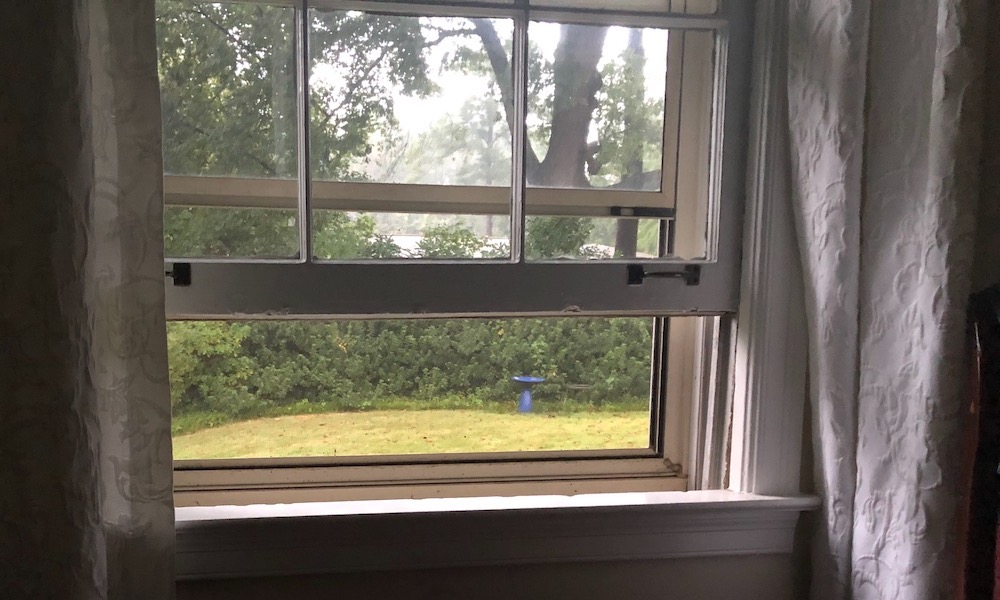
So, do airtight houses need makeup air? Well, when you need any at all, you probably just need to open a window enough to provide a little bit of makeup air when necessary.
________________________________________________________________________
Allison A. Bailes III, PhD is a speaker, writer, building science consultant, and the founder of Energy Vanguard in Decatur, Georgia. He has a doctorate in physics and is the author of a popular book on building science. He also writes the Energy Vanguard Blog. You can follow him on Twitter at @EnergyVanguard. Photos courtesy of the author.
Weekly Newsletter
Get building science and energy efficiency advice, plus special offers, in your inbox.





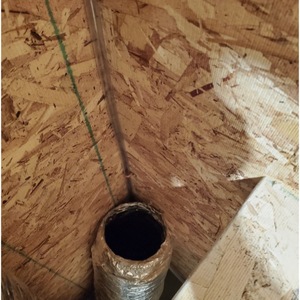
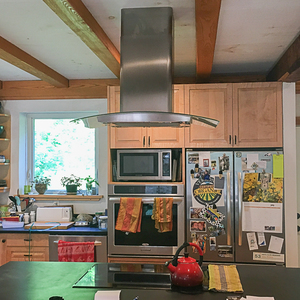
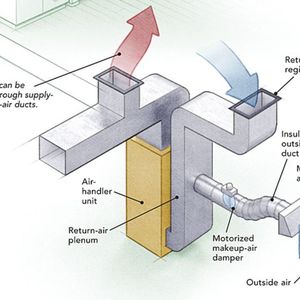
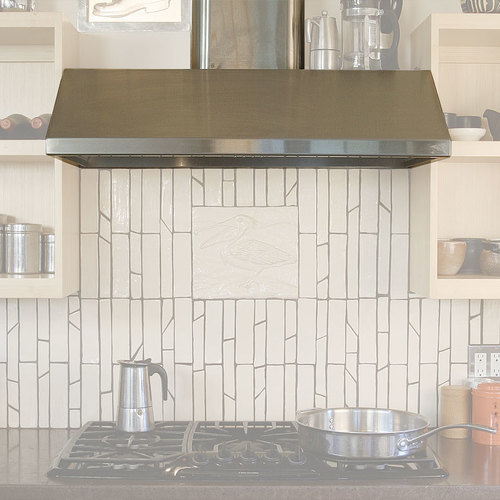






21 Comments
Thank you for this blog post.
Can the effective exhaust capability of a range hood be predicted at different levels of air tightness? For instance, let’s say that you convinced me to use a range hood with <400 CFM?
Thanks!
You need the interior volume OR the blower door CFM, but not both.
The conversion between ACH and CFM is
60 x (CFM_50)/(interior volume) = ACH_50.
If you have the blower door data in CFM at 50 Pa (CFM_50), that's the CFM of makeup air you'd get at 50 Pa, so that would be an aggressive upper limit for exhaust without makeup air. If you have the ACH, then you also need the volume (in cubic feet) to calculate the CFM_50.
You would also likely need some more info on the fan to really predict much. 400cfm is a rating at a particular pressure as well. Probably a fairly low differential. Some fans fall off pretty dramatically as the pressure across the fan changes. Others can maintain more airflow. Depends on the design.
You're going to need the fan curves for the range hood that's being considered. Usually somewhere in the product literature, but often impossible to find especially for inexpensive hoods. You'll need to calculate the pressure drop for the hoods duct work to the outside, don't forget the drop for the termination at the outside. Then you add the pressure drop across the building envelope. (50pa = 0.2 IWC) The house is basically acting like duct work on the intake side of the fan. Together you get the total external static the fan has resisting it. Take that to the fan curve chart to get your air flow. Also, note that house pressure at a given CFM is what matters here. If you're design with an ACH50 target for the home you'll need to turn that into CFM50 with formula Charlie gave, and then do a bunch of interpolating or extrapolating.
In reality this all a bit squishy and prone to error.
The big concern for me is often people want a large wood stove and range hood in their new tight will insulated home and the large range hood can easily back draft the wood stove.
Walta
Walta,
I have a not particularly tight house, and my small CFM range-hood or clothes dryer can cause my wood stove to back-draft.
As regards a wood stove back-drafting when kitchen or bathroom fans are on, aren't wood stoves, like pellet stoves, supposed to be airtight and have an external air supply?
NearCoastalBC,
Many jurisdictions still allow the combustion air supply to be installed in close proximity to the wood stove or fireplace.
But whether the air is directly or indirectly supplied, the negative indoor pressure induced by fans only has to overcome the stack effect in the chimney to draw smoke into the house. I have this problem in my 1200 sf not very tight house when the range hood or dryer is on unless I open a window.
https://www.woodheat.org/the-outdoor-air-myth-exposed.html
It's not just about pressures. Energy Vanguard designed 2 MAUs for a house I designed with two kitchens. Both kitchens will have induction cooktops and 2 gas burners. The main reason for the MAUs is that the Owners cook mostly ancestral foods from overseas.
Take note, most Asians, Africans and Hispanics cook with lots of spices, and if any members of their family has respiratory issues, like my clients, an MAU is a required appliance.
Although they may or may not make economic sense - cool tubes (often
called "earth tubes") might really make sense (for energy efficiency)
in airtight housing. Especially if the air flow were controlled by an
electronic damper which opened when the range hood and/or exhaust
fans were in operation. I realize they were an idea popular back in the
days of "hippies" but that doesn't automatically disqualify!
Gstan, earth tubes are a great idea in theory, but they often have problems. Just yesterday I saw Katrin Klingenberg of PHIUS do a presentation on the history of Passive House and she used her own house as an example. She had 8" earth tubes and they filled with water due to condensation (and maybe leaks, I forget) so she had to abandon them. Moist air and cool tubes are a recipe for condensation.
I just wanted to second this. The reality of earth tubes is a maintenance and potential air quality disaster. It's one of those things that's tempting until you start thinking through all the details. Also, if you dig into the math the savings just don't pencil for all the fuss.
Every serious article I've seen on earth tube design recommends installing them on a slight slope and providing drainage, so no ET system should "fill with water." Really big systems, like the one at the Earth Rangers Centre in Woodbridge, Ontario (https://www.canadianconsultingengineer.com/features/earth-rangers-revisited/) may have to use some sort of dehumidification, but it's not a residential system!
We know that warm air coming into contact with a cool surface will condense; isn't this the principle in the heat exchanger part of a condensing boiler?
I put an earth tube cooling system in my small house last summer (1100sf, with a vaulted ceiling and loft bedroom); 120' of 6" PVC pipe and a 6" inline fan, bringing the air up the central staircase from the basement, venting into the main room, which also has a 52" ceiling fan. I also mounted a 20" box fan in the upstairs bedroom window to draw out warm air. Only semi-scientifically designed, but so far it keeps the house about 8-10ºF cooler inside than outside. Next week it's supposed to hit 90ºF here so I'll see how it does at those temps. The two fans only draw about 200W.
"Filled with water" was Katrin's description, not mine. Yes condensation is the mechanism behind lots of HVAC processes and it's good for other things, just not when you're bringing in what's supposed to be fresh air through a long, moldy pipe. If you're near coastal BC, your average annual dewpoints are relatively low (i.e., dry) which will work in your favor, but I would still be cautious. If you start experiencing extended flu-like symptoms, you might want to test for mold.
Yes, I wondered about that wording! A little hyperbole goes a long way...
I've had no problems with condensation or mould, probably, as you say, because we're fairly dry out here (about 50 miles inland from Vancouver). The interior environment seems normal, just cooler :)
Michael,
You could use a glycol ground loop + circ pump + fancoil in that Make air duct with the circ pump engaged with the vent hood. No problems with condensation in an earth tube..
Yes - it will work, Is it (too?) complicated - maybe.
regards
I apologize in advance for being a chemical engineer now retired. I am a wet head, I.e, hydronics proponent who is an advocate for energy and mass balances. Why use air when water or glycol is easier to move or model? As for Make up air why not derate the vent hood fan to only pull 300 CFM? Add a sensor to the ERV to compensate? This is a HVAC controls problem! Apparently only Building Equinox has a solution. Time to move to Whole House Controls.
Allison, as usual your articles are very clear and concise for the masses :-) Nice work there.
Birchwood, my approach to this challenge was more or less as you described. Fantech, AC Infinity, and Terrabloom (among many others) sell EC fans which can be wirelessly managed by using 0-10v controllers from Zooz or Leviton.
1. The inline kitchen exhaust fan varies speed with load on the induction cooktop varying CFM on need.
2. When kitchen exhaust is running, the HRV runs an unbalanced flow profile to provide make up air.
3. Co2, Radon and VOC levels control the home's vent rate via AirThings or Ecowitt sensors on each floor.
Is this all overkill? Maybe, but it made for a very interesting project. The 0-10 controllers are $50-80 bucks and the EC fans I'm using range from $100 to $150 each. Hubitat hub is about $140. The bath exhausts in our home are old school on timers still but if I was doing them new, I'd use inline fans tied into the system for sure.
Here in Oregon (and I think also in Washington) balanced ventilation is now required in homes and apartments. We just built 70 small homes and apartments as part of an affordable housing cooperative and put a butterfly damper ducted straight through the exterior wall behind the refrigerators. The fridge will hopefully offset the cold air draft in winter. This seems like a no nonsense way to ensure range hoods and bathroom exhaust fans work as planned in these airtight structures. It's really a very easy solution, and although there may be some wind-induced infiltration at times, it seems preferable to exhaust fans that don't work and/or pull air from random envelope leakage points.
Re: make up air systems: we recommend TESTING the installed system to measure depressurization and make sure it is low, mechanical damper works etc. (based on recommendations from Florida Solar folks). See Issue Brief, Caveats & Cautions, and slides/video, at ROCIS Kitchen Range Hood pages, https://rocis.org/kitchen-range-hoods/
Thanks again for a great article and discussions.
Tom Phillips, ROCIS Technical Advisor
" But we can turn it around to say that an airflow rate of 100 cfm will induce a pressure difference of 50 Pa. With the house closed up, turning the range hood on low can induce that much negative pressure. Wow! That’s a big pressure difference. Is it a problem? Maybe. Maybe not."
50 Pa is a tiny amount of pressure, unnoticeable without instruments. It's 0.00725 PSI. It's the pressure difference experienced when walking upstairs about six feet. Unless you have combustion appliances that don't have a separate air feed it's not worth worrying about.
Log in or create an account to post a comment.
Sign up Log in